
 |
|
|
#121 |
|
Member
Join Date: Jul 2006
Location: Buraimi Oman, on the border with the UAE
Posts: 4,408
|
On passing ...so before I forget where I am ... these Omani shields said to have been worked in Zanzibar have a couple of geometric flat devices covering the outer shield at the 2 points where the spiggots are located holding the hand grip in place. It strikes me that these shapes reflects a certain geometry that we have observed in other Zanzibar swords... such as the Nimchas...with the odd pommel top decoration and the decorative marks on the quillon ends are similar.
Ibrahiim al Balooshi |
|
|
|
|
#122 |
|
Member
Join Date: Jul 2006
Location: Buraimi Oman, on the border with the UAE
Posts: 4,408
|
An odd straight Omani Dancing Sword with a numbered blade. New.
This sword was given its hilt and scabbard in the central region around Nizwa. The makers said that it(The Blade) was a "Roosi" The weight is double that of a normal Saif and the bend is ok but by no means a full 90 degree... more like half that...Roosi by the way means Russian..The assumption is Russian imported blade ... however I have to say it is the first I have encountered. Weird number  Ibrahiim al Balooshi. |
|
|
|
|
#123 |
|
Member
Join Date: Jul 2006
Location: Buraimi Oman, on the border with the UAE
Posts: 4,408
|
Salaams All..Part of the tradition involves handing over the history to the children...Here is the small dancing sword given to boys about 8 years old with which to practice the Funun ... The Traditions. Other new inexpensive full sized dancing swords shown are sold in the market as wedding accoutrements while old family heirloom swords are kept for special occasions and are quite valuable...
All dancing swords are very flexible, often able to bend fully from the tip in a full circle and then when released spring straight immediately. The swords are sharp on both edges and round tipped reflecting and in honour of the forefathers who went into battle with the Old Omani Battle Sword ...which had the same sharp edges and round slashing tip and was the only Omani Battle Sword... tried and tested down the ages. Regards, Ibrahiim al Balooshi. |
|
|
|
|
#124 | |
|
Member
Join Date: Jul 2006
Location: Buraimi Oman, on the border with the UAE
Posts: 4,408
|
Redirected post..
Quote:
Salaams~ But why would I seek out such a modern cross hilt...stiff bladed?? You mean an Ethiopian blade..... I'm not due in Muscat Souk for a few months...I have handled lots in Muttrah. see http://www.klm-mra.be/icomam/downloads/issue07.pdf where on page 89 you can see some swords several of which are rehilts ... The chap with the beard is a silver master in his own right... He did the cross hilts...like his father from 1970 onwards... I recall seeing and handling these and they were stiff blades. He told me he got them from Salalah and they got them from Sanaa from Ethiopia... One of them was marked Solingen. I believe I have pictured that somewhere...checking....oh yes on Kattara for Comments where I show some of the same swords as per the above reference from icoman... What I do know is that the quite heavy iron and sometimes silver inlaid scabbard furniture comes from Omani Battle Sword Scabbards...but where a sword is to be used for its correct purpose (pageants) it has to be flexible or it will not buzz...That has always been the case. The stiff blades are not another type ... they are rehilts from Ethiopian blades. etc etc. and Omani people do not buy them... because they arent right...too stiff...Tourist Blades ... Like the one in your collection? Here is Tipu Tip with a 19th C Omani dancing sword ...The Straight Omani Saif... with heavy duty Furniture to the scabbard...and in the classic style ... To raise the price of the tourist variants ...(those blades brought from Ethiopia mainly from 1970 onwards), craftsmen copied this style exactly...adding the long hilt and scabbard complete from Omani style. Ibrahiim al Balooshi. Last edited by Ibrahiim al Balooshi; 14th July 2014 at 08:29 PM. |
|
|
|
|
|
#125 |
|
Member
Join Date: Oct 2007
Posts: 2,818
|
See my other reply.
|
|
|
|
|
#126 | |
|
Member
Join Date: Oct 2007
Posts: 2,818
|
Quote:
When you can find a suitable candidate for my request, please let me know and I will pick up again where I have left off. Doing so might really help your theory and add some BUZZ back in to the debate. |
|
|
|
|
|
#127 |
|
Member
Join Date: Jul 2006
Location: Buraimi Oman, on the border with the UAE
Posts: 4,408
|
I note you are now a dealer in Tourist Swords... cant be good for business perhaps?...Below is another enactment where the participants chuck the sword as high as they can and catch it by the hilt cleanly before it strikes the ground..Doing this with stiff blades would indeed be dangerous...as would be the mock fight and I have not noticed a lot of thumbless Omani men walking about...or worse still lots of dead performers...

|
|
|
|
|
#128 | |
|
Member
Join Date: Nov 2004
Location: USA
Posts: 1,725
|
Quote:
I "request" you resist the urge to continue debating in this fashion. The alternative will result in consequences including, but not limited to, closing of this thread. Andrew Vikingsword Staff |
|
|
|
|
|
#129 | |
|
Member
Join Date: Oct 2007
Posts: 2,818
|
Quote:
Based on several quoted texts of old, the description of these swords describe them as being fine and razor sharp cutting edges so I do fail to see how doing this with stiff blades would be any more dangerous than a blade with bend to it, especially IF a bendy blade had these qualities. A bend in the blade is not active in any manner of "chucking" a sword straight in to the air, it is the edges one must be concerned with, not bends. For the mock fighting, the same can be said, why were the swords ever credited with being such high quality and razor sharp swords than can nearly hew a man in two, it serves no point in these acts is it is only to be danced with, why would one add danger to their lives and risk loosing a thumb as you say. Like any act, which the dancing and mock fighting it, it is an act only, it can be done with the sharped or dullest swords. Neither of these points you make add to the fact that the swords were not fighting swords...in fact they do in ways support the swords were able to be fought with. |
|
|
|
|
|
#130 | |
|
Member
Join Date: Jul 2006
Location: Buraimi Oman, on the border with the UAE
Posts: 4,408
|
Quote:
What compounds the arguement in addition to the mistaken remarks of the earlier visitors is the flexibility of many other swords... I believe the swordmaker from the Shotley Bridge sword company took one of his blades coiled up in his top hat to a sales meeting and unleashed it to astonished guests. I know another sword I think from the Sahara which wraps into a coil and is used like a lashing whip...I understand the concept...but that is not what this sword is about... Regards, Ibrahiim al Balooshi. |
|
|
|
|
|
#131 | |
|
Member
Join Date: Oct 2007
Posts: 2,818
|
Quote:
The audacity of such a comment with its poor, inflaming and unfounded intent adds nothing but takes away a lot...but not from me. Last edited by SwordsAntiqueWeapons; 14th July 2014 at 10:39 PM. |
|
|
|
|
|
#132 |
|
Member
Join Date: Oct 2007
Posts: 2,818
|
Would someone who is savy with creating a video for youtube please write me privately.
Anyone who is savy in test cutting too would be helpful. With thanks |
|
|
|
|
#133 |
|
Member
Join Date: Aug 2007
Location: CHRISTCHURCH NEW ZEALAND
Posts: 2,789
|
Originally posted at #76 of the Forts and Cannon of Oman thread which is now closed, Ibrahiim has stated that the so called Dancing sword was "brought on and expanded into the population from the palace guards".
My question is this: WHY WOULD YOU GUARD A PALACE WITH A DANCING SWORD? A sensible reply would be appreciated. |
|
|
|
|
#134 |
|
Vikingsword Staff
Join Date: Dec 2004
Location: The Aussie Bush
Posts: 4,398
|
Before this thread gets closed down as well, let me say that I interpret most of Ibrahiim's comments to indicate that certain swords have assumed ceremonial or ritual status rather than military status.
I think we can readily find examples in western culture where this is now the case. For example, the British monarch has the Horse Guard. These are mounted troopers who carry swords (and maybe lances as well at times--I'm not sure about that). In any case, these are ceremonial troops whose swords (sharpened or not) would be completely ineffective in protecting the Royal Family from a modern attack with automatic weapons. The Horse Guard adds pageantry to royal activities and reminds the British of past traditions and former "glory." I think this might be what Ibrahiim is getting at when he speaks of "heraldry." As far as dance swords, I am reminded of Scottish sword dancing where former weapons, now ceremonial, are still used as props in traditional dancing performances. So I'm having no problem understanding much of what Ibrahiim is saying here. It's not clear to me why there is so much heated discussion about this topic. What is clear, though, is that the Moderators will shut down this thread as well if it gets out of hand. Personally, I would like to hear more sword discussion on this topic because it is an area about which I know very little. Ian. |
|
|
|
|
#135 | |
|
Member
Join Date: Jul 2006
Location: Buraimi Oman, on the border with the UAE
Posts: 4,408
|
Quote:
Thank you for the question... I prepared the answer yesterday... As you know Palace Guards or Askeris were armed substantially with Khanjar, Spear and the long gun... The Abu Futtilla. The dancing sword when carried (and terrs) were ceremonial . A large slice of a Guards daily program would have been to do with pageantry... and salutation...actually not altogether removed from ceremonial guard duty today. Pageantry includes the mock fight which is incorporated into the Funun...and which would form a good workout as each man took his turn... Regards, Ibrahiim al Balooshi. Last edited by Ibrahiim al Balooshi; 15th July 2014 at 08:31 AM. |
|
|
|
|
|
#136 | |
|
Member
Join Date: Jul 2006
Location: Buraimi Oman, on the border with the UAE
Posts: 4,408
|
Quote:
A note on heraldry as it is likely that the Heraldic Society would never accept the terminology but it fits in general; The current Dynasty commenced very roughly in about 1744...and the Dancing Sword was concocted at that time or shortly therafter, thus, I term it Heraldic~Dynastic. To salute the monarch and conduct the traditions or Funun...until today. It had to be extremely flexible but was also razor sharp and spatulate tipped in honour of the forefathers who went into battle with another weapon upon which it was largely designed; The Omani Battle Sword. See thread on that please. I have compared the Dancing Sword with the Omani Batle Sword but the new part of the design was the long Omani Hilt taken from the Omani curved Kattara (see that thread please) which was a slave captains sword and Merchants Sword acting both as a badge of office and a defensive weapon/punishment item. I have searched high and low ... but no evidence exists anywhere of any battle in which the dancing sword may have been used and when you see the blade it is pretty clear why... It is not a battle blade and is weak and very flexible... thus excellent as a safe sword to buzz at march pasts and pageantry. The killer sword in the Oman armoury has always been the Omani Battle Sword which could take a mans leg off but is stiff and configured differently in the hilt... The late Anthony North expounded on the now well known theory of retaining a weapon that worked... That is the case here... The ancient Old Omani Battle Sword is honoured from about the mid 19th C with a replacement Royal Hilt which can be seen today~ even carried by the Ruler although any man can wear it...And most of them do! though at the time when it was inaugurated the population was by comparison much smaller and it permeated across the population rather than exploded but would have spread in popularity steadily..via the Palace and religious guards... The very important functions handed over at the beginning of this Dynasty were from the Old Omani Battle Sword to the new dancing sword...including the buckler shield; as I say... in honour and for Pageant and Salutations...but not the fighting function. Since 1970 masses of Ethiopian straight stiff blades have been expertly rehilted on Omani Longhilts and Omani Scabbards in Muttrah Souk Muscat having been imported via Yemen from Ethiopia...often made in Germany. These are not original Omani fighting swords but classed as Tourist items. That is the point of the discussion. Regards, Ibrahiim al Balooshi. |
|
|
|
|
|
#137 |
|
Member
Join Date: Mar 2010
Location: Olomouc
Posts: 1,717
|
The example I'd be interested to see which I don't think I have yet in this thread or the other discussions about this type, would be a dated late 18th or early 19th century dance/parade sword. I've seen plenty of the more recent ones with flexible blades, but not a dated older one.

|
|
|
|
|
#138 |
|
Member
Join Date: Sep 2013
Posts: 79
|
Ibrahim, I'd like to adsk about the last photo with two swords in your last post. Are they also "dancing swords"? Are the form of hilts and blades of those swords specific only to the dancing swords? Because I remember seeing the exact same shaped sword in Istanbul Military Museum. It was a Memlük sword; belonged to a Memlük sultan if I remember correctly and it was definitely for battle.
I'm desperately searching for photos right now. But I am 100% positive it was very very similar to the swords in your photo. |
|
|
|
|
#139 | |
|
Member
Join Date: Dec 2004
Posts: 1,712
|
Quote:
I think the point here that people are arguing about is Ibrahim states that all solid bladed straight kattara with the typical Omani style hilt. {Not the all metal one.} are fake. {He believes only the curved ones ar for fighting.} That all swords of that type should have very bendy blades & just be used for dancing. {since around 1774!} But the modern copies he shows & the information he pronounces as gospel, that comes from the fakers of modern day marriages look like the copies they are. But to malign every stiff bladed kattara ever sold or collected in the west {excepting the all metal hilts.} as fake, without substantiating it is wrong. To say non of these swords were ever used in battle is wrong. To say the sword was not very important unlike spears or guns after C.1744 is also wrong. IMHO Spiral |
|
|
|
|
|
#140 |
|
Member
Join Date: Sep 2013
Posts: 79
|
Here are pictures of two swords from İstanbul Military Museum. Both are signed and there are no questions and doubts about their origin and age. I believe this will give new clues about the subject at hand(I am sorry that photos are a little dark):
First one is a Memlük sword from 13th century: 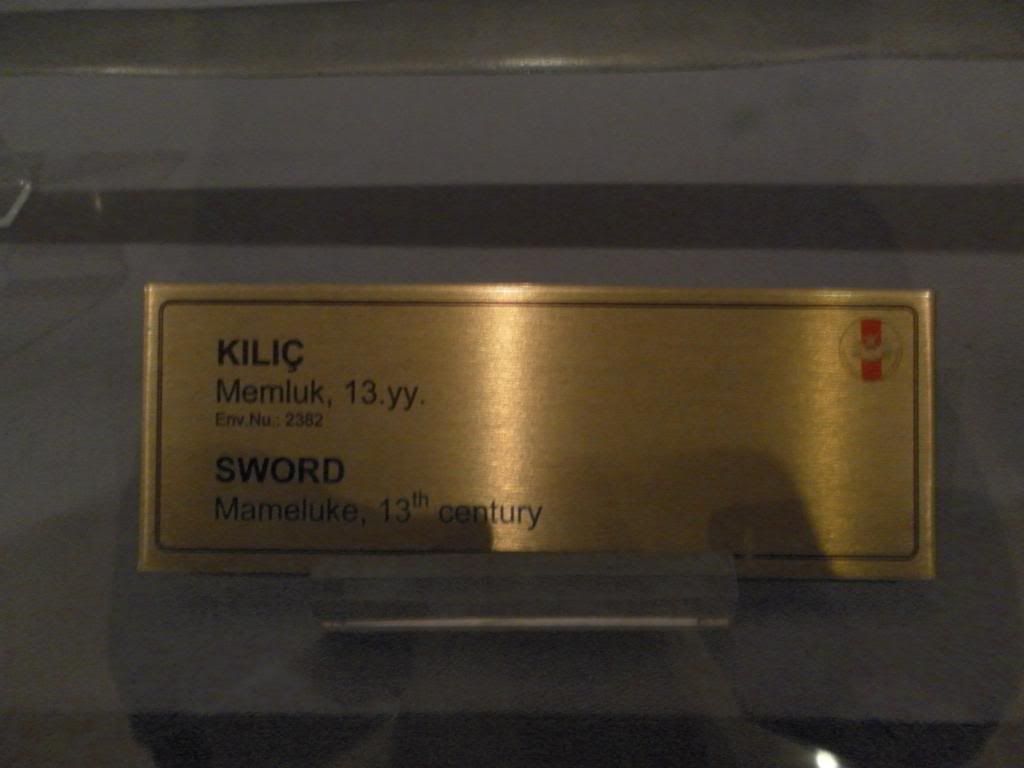 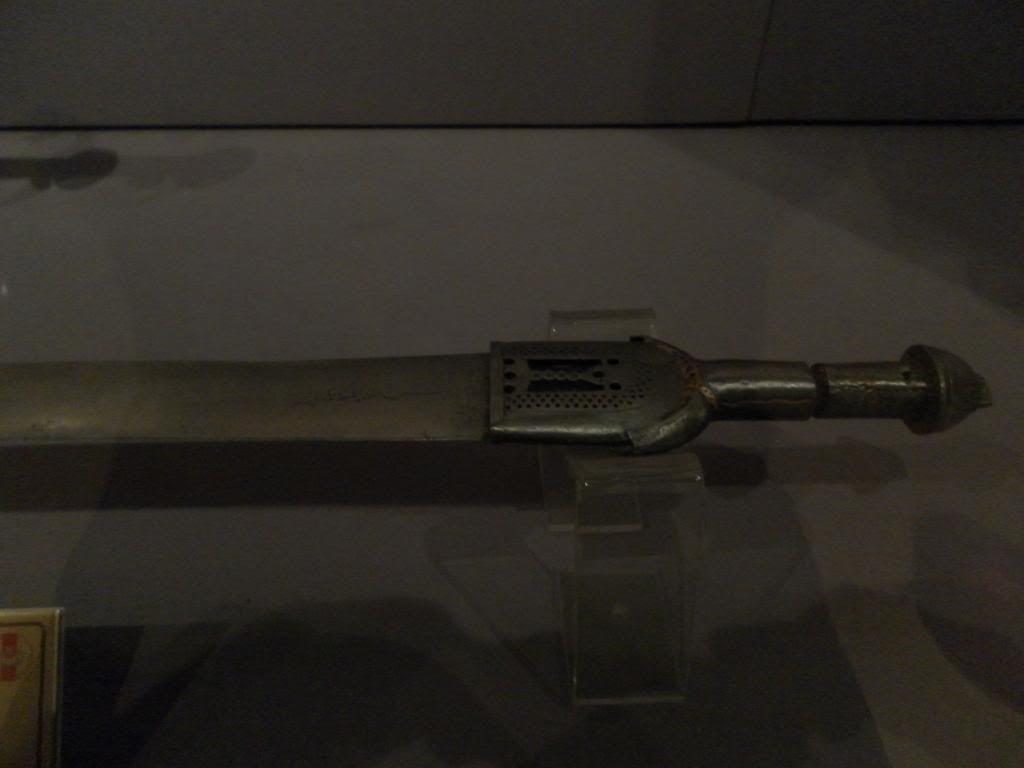 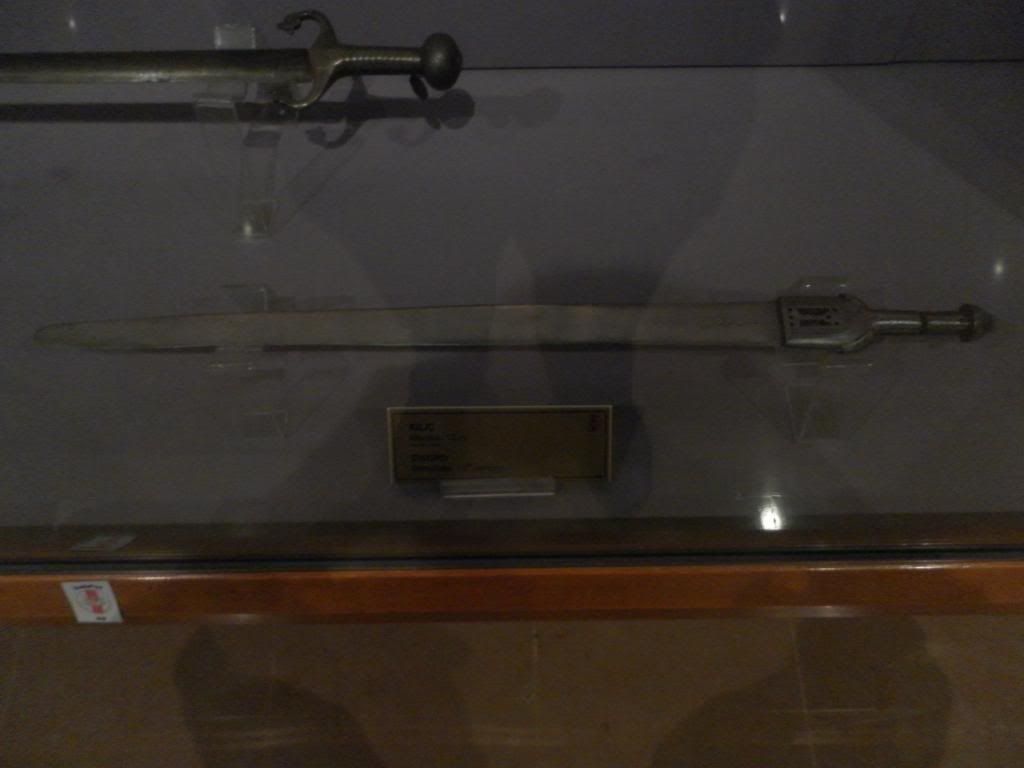 Second one is an Eyyubi sword from 12th century; made for Necmeddin Eyyub: 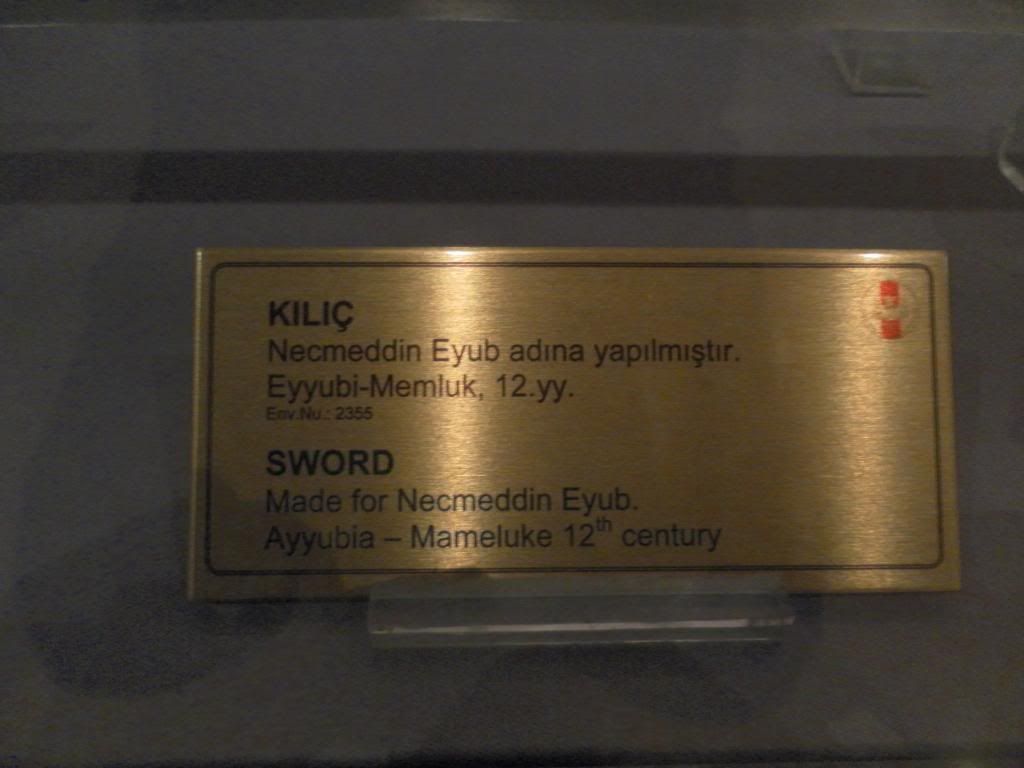 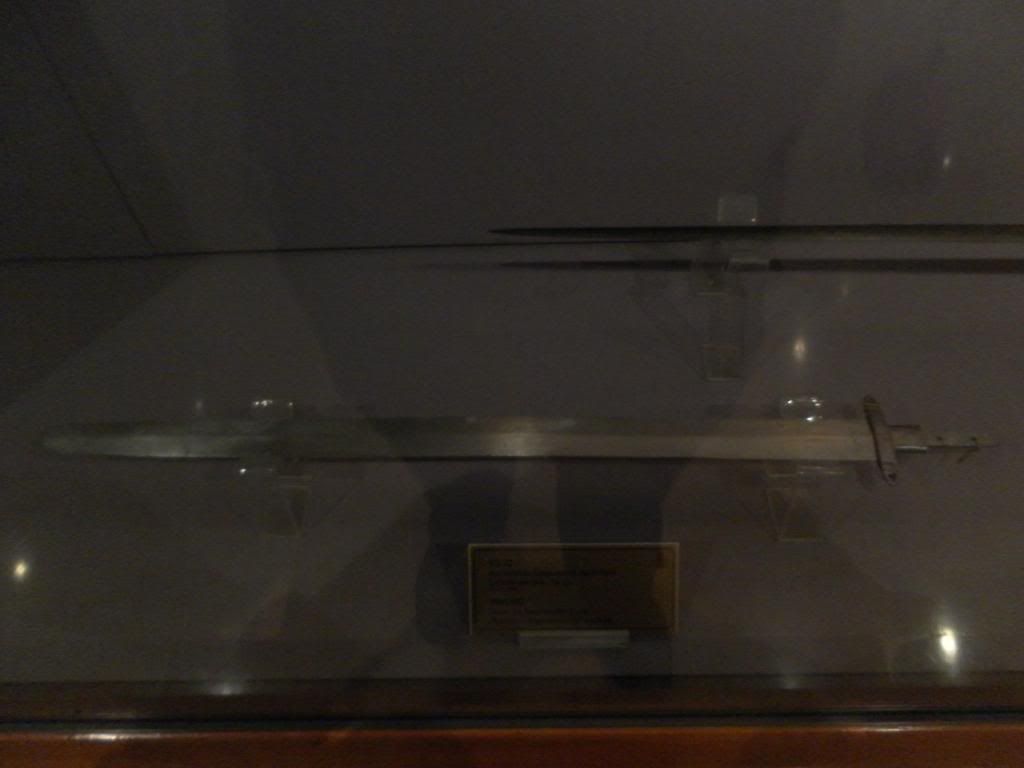 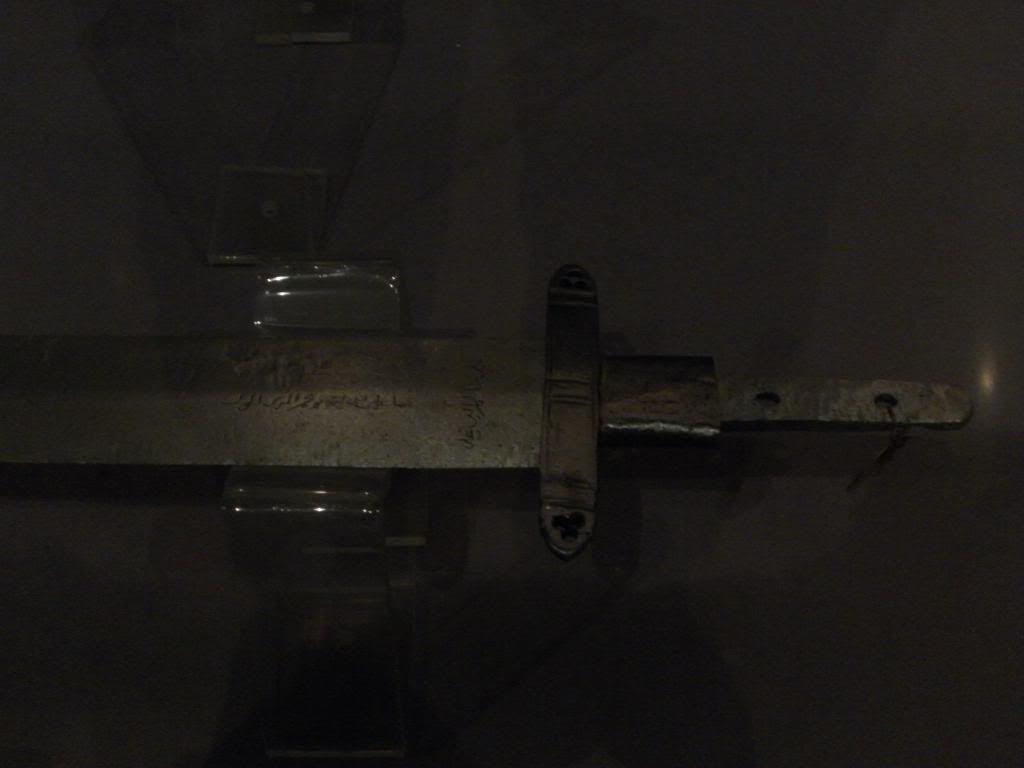 I know two little about the topic at hand(and I thank both participants of the discussion, I learned a lot from this topic) but to my uneducated eyes, these sword look very very similar to "dancing swords" mentioned here. They even have rounded tips. (I also want to add Indian straight sword Khanda also has rounded tips yet they are battle swords) |
|
|
|
|
#141 | |
|
Member
Join Date: Jul 2006
Location: Buraimi Oman, on the border with the UAE
Posts: 4,408
|
Quote:
Please note;In order to help you differentiate the 3 swords I have placed above the pictures at #135. There's~ 1.The Old Omani Battle Sword. Battle Sword. Straight and stiff. 2.The Curved Kattara. Merchant and Slavers Sword. Curved. Quite rigid.. 3.The Omani Dancing Sword. Pageants and Salutations ...The Dynastic Item...Dynasty started 1744 but sword would have taken time to promote perhaps 15 years. Straight and very flexible. Ibrahiim al Balooshi. |
|
|
|
|
|
#142 | |
|
Member
Join Date: Jul 2006
Location: Buraimi Oman, on the border with the UAE
Posts: 4,408
|
Quote:
Yes you are right... they are in somewhat short supply but I am looking and one will surely turn up. It would be interesting if I could find the initial commissioning document but no such detail appears to exist...and it is quite hard to determine the precise Ruler who kicked off the dancing sword trend but I tend to favour the first since he was also an IMAM...Having said that it could be that the item did not start until the advent of Said bin Sultan in 1804. See http://en.wikipedia.org/wiki/Said_bi...uscat_and_Oman Ibrahiim al Balooshi. |
|
|
|
|
|
#143 | |
|
Member
Join Date: Dec 2004
Posts: 1,712
|
Quote:
That post was for the moderators Ibrhaim, but as you wish to engage myself, {although you ignored what I said & just posted the same stuff yet again, as if.. I failed to understand.  So to reiterate. I need no help to differentiate Ibrahim.  I think you do... You missed out numbers 4. & 5.  4. The straight bladed fighting Kattara 5. The straight bladed kattara fake made by dodgy Omani dealers in the souk. Hope that helps clarify it for you? Spiral |
|
|
|
|
|
#144 | |
|
Member
Join Date: Mar 2010
Location: Olomouc
Posts: 1,717
|
Quote:

|
|
|
|
|
|
#145 | |
|
Member
Join Date: Jul 2006
Location: Buraimi Oman, on the border with the UAE
Posts: 4,408
|
Quote:
Indeed. What is equally interesting is the absolute lack of information anywhere connecting the early dynasty with the dancing sword. I take the formal guestimate of 1744 as the date of the first Ruler of the current dynasty but not a single dynastic sword clue exists and til now I have wondered why? In seeking out the best contender for the introduction of a dynastic sword logic points the finger at the ruler; Said bin Sultan ruled with his brother for a couple of years 1804 to 1806 then singly after than til he died in 1856 off Zanzibar. During his rule a number of Dynastic items appeared including the Royal Turban and the Royal Hilted Khanjar designed by Sheherazad... one of his wives...and at some later date the Battle Sword was made a Royal Hilt. It was during this time that the strategic manouvre to develop Zanzibar happened... Could it be that the dancing sword actually popped up a lot later than I am searching for... and that is why no very early swords exist?...Perhaps it was at the front end of his rule in the 1810 region...but that the full flow out to the regions and general population took a lot longer...(ie whereas troopers had the thing but the general population got it a lot later).... Thinking aloud...that could explain a lot. I have rechecked the Richardson and Dorr and few clues exist ...which is interesting. Their weapons make up a sizeable set of the countries museum stock. I shall endeavor to research the archives at the National Museum since their display is dynasty dedicated. Regards, Ibrahiim al Balooshi. |
|
|
|
|
|
#146 |
|
Member
Join Date: Jan 2012
Posts: 411
|
Ibrahim,
I am a little confused here. Are you saying the sword hilt illustrated in post#68 on the now closed "Forts and cannons..." thread is a post 1970 muttrah souk rehilt on a german\ethiopian blade for the tourist trade? I can see it is a modern hilt but it's quality seems to me suggest a very superior tourist was needed to buy it. Would such a sword really be dismissed by a native Omani as "bazaar rubbish"?. To me, it looks very desirable, at the right price, of course. Regards Richard |
|
|
|
|
#147 |
|
Member
Join Date: Dec 2004
Posts: 1,712
|
Hello Chaps!
 Heres a little montage of pictures to illustrate my view of Omani sword type 4... The straight bladed fighting Kattara. First we have Mr. Tipu Tip. {As the Colonial English called him for a laugh...} Whos Real name was Hamed bin Mohammed. Then we have Mr. Tiippy with A couple of other Arabs & Some Brit Colonial Officer type. Notice how they all wear fighting Swords, 2 Omani Shamsir & a type 4, Stiff bladed fighting Kattara. Then this fascinating Bunch of Baluchi cutthroats employed by the Omanis as the Baluchis made good soldiers & Guards. Note straight bladed Saif helb by middle chap amongst all the shamshirs. I suspect Ibrahim will say this bloke was waiting for the band to arrive so they could all have a dance, But personaly I reckon , hes a cold stome killer with a weapon... hes not waiting for top of the pops to start! Then a number of Omani. Zanzibari rulers are presented to show the importance of wearing a combat worthy sword as a ruler. They weren't going to wave them in the air & have a sing song! They were weapons carried to show there power... as were Tippy toes... Who carried both straight & curved kattara as illustrated above. Spiral |
|
|
|
|
#148 | |
|
Member
Join Date: Jul 2006
Location: Buraimi Oman, on the border with the UAE
Posts: 4,408
|
Quote:
No where did I say that? ... Its a hilt from one of the Museums. Its a hilt by a modern master probably 15 years old only. Regards, Ibrahiim Al Balooshi. |
|
|
|
|
|
#149 | |
|
Member
Join Date: Jul 2006
Location: Buraimi Oman, on the border with the UAE
Posts: 4,408
|
Quote:
Salaams Spiral, I am not sure what you are researching by illustrating these pictures ...what is your point here please...? I see dancing straight saifs and some Shamshiirs worn by dignitories...only...and some Khanjars of the Royal style..To a man these are being worn as a Badge of Office. Ibrahiim al Balooshi. |
|
|
|
|
|
#150 |
|
Member
Join Date: Oct 2007
Posts: 2,818
|
Here are a couple of old English drawings from Zanzibar.
Artists impressions were more than accurate in the hey day of world travel, conquest and documentation as they had no other means in capturing details other than writing. Dancing with curved swords and fighting with straight swords. Gavin |
|
|
 |
|
|